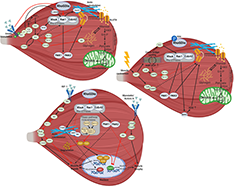PhD defence: Novel molecular mechanisms in Rho GTPase-mediated regulation of muscle mass and insulin sensitivity
The role of RhoGDIα and group I PAKs
Lisbeth Liliendal Valbjørn Møller
PhD thesis

Skeletal muscles are critical for whole-body glycemic control and crucial for maintaining an independent lifestyle. The loss of muscle mass is common in several pathological conditions that are associated with a reduced ability of insulin to increase muscle glucose uptake. Thus, understanding the molecular mechanisms underlying this phenomenon is vital.
In addition to insulin, muscle contraction also increases muscle glucose uptake. The Rho family GTPase, Rac1 is highly important for glucose uptake in response to both insulin and muscle contraction. However, how Rac1 is activated and regulate glucose uptake is incompletely understood.
The present PhD thesis aimed to identify novel molecules that interact with Rac1 in muscle. It was discovered that inactive Rac1 interacted with a protein called RhoGDIα. RhoGDIα is an inhibitor of Rho GTPases.
Accordingly, the importance of RhoGDIα in the regulation of Rac1 activity and muscle glucose uptake in response to insulin was investigated. Rac1 activates a group of molecules called group I PAKs. Thus, additionally, the importance of group I PAKs for muscle glucose uptake in response to both insulin and muscle contraction was explored.
The present PhD thesis demonstrates that RhoGDIα is an inhibitor of Rac1 in skeletal muscle cells. Furthermore, increased expression or depletion of RhoGDIα in muscle identified RhoGDIα as a negative regulator of muscle glucose uptake in response to insulin. Increased muscle RhoGDIα expression also impaired glucose tolerance at a whole-body level in mice.
Thus, the observed increase in RhoGDIα expression in muscle from type 2 diabetic subjects could potentially explain the previously reported dysfunctional Rho GTPases in these subjects in response to insulin.
Interestingly, it was found that RhoGDIα is also important for muscle mass. Lastly, glucose uptake in response to insulin and muscle contractions was found to partly depend on PAK2, but not PAK1, in mouse muscle.
In conclusion, RhoGDIα is identified as a novel regulator of muscle mass and insulin sensitivity and evidence is provided that Rac1-mediated glucose uptake partly depends on PAK2, but not PAK1.
2020, 243 pages.
Time
10 June 2020, 14:00
Place
Digital defence.
Opponents
Associate professor Faidon Magkos (chair), Department of Nutrition, Exercise and Sports, University of Copenhagen, Denmark.
Professor Anna Krook, Karolinska Institute, Sweden
Professor Markus Rüegg, Basel University, Switzerland
Supervisor
Professor Erik Richter, Department of Nutrition, Exercise and Sports, University of Copenhagen, Denmark.
Co supervisor
Assistant professor Lykke Sylow, Department of Nutrition, Exercise and Sports, University of Copenhagen, Denmark.
The thesis is available for inspection at Nørre Allé 51, DK-2200 Copenhagen N.
